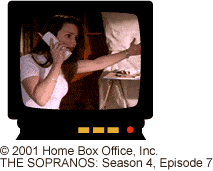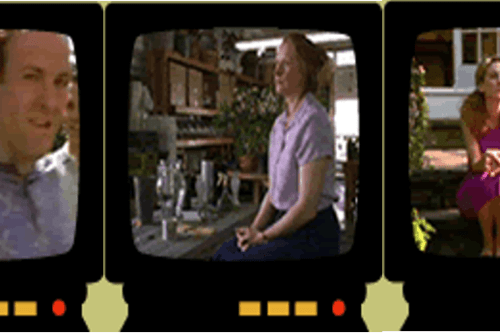The Trouble with Liberal Feminism

Since the Home Box Office (HBO) is less constrained by a push for network-TV-like ratings and, given that it generates revenue from its viewers and is thus not dependent on advertising dollars, its programs’ producers can instead focus on crafting intricate story lines that allow for the complexity of characters. HBO may be less concerned about falling within the comfortable range of emotions or, in this case, gender displays that are standard on mainstream series. By placing work at the center of Carrie, Samantha, and Miranda’s lives and identities, rather than as something to be abandoned at marriage, Sex and the City allows for a more “realistic” or in-depth story to be told. In fact, Charlotte’s own insecurities about her decision and her concerns regarding how she would be judged also communicate the idea that work is and should be important to women. Her defensiveness, which comes through forcefully in a subsequent phone conversation with Miranda, implies that she realizes that she might have regrets about not working and that she has internalized the message that she should work. When, for example, she accuses Miranda of judging her and exclaims, “You think I’m one of those women . . . One of those women we hate who just works until she gets married!” Charlotte reveals her own view that women should be independent, which demonstrates that she herself is conflicted. This statement has feminist undertones (although the divisiveness among women it suggests is decidedly not feminist), since it implies that women who change their lives, or who are primarily oriented to attracting a husband, sacrifice themselves and comprise their identities.
When she demands that Miranda support her decision, Charlotte claims that, given the women’s movement, she has the right to choose whether or not she should stay home. She shouts into the phone repeatedly, “I choose my choice!” as if to say her decision is OK because it is supported by feminism. When Charlotte says these words, when she decides to stop working, she calls on a principle associated with liberal feminism—that every woman has the right to decide for herself what is best. This both oversimplifies and misinterprets liberal feminist goals, while still promoting the critical sentiment that women are diverse, and that one woman’s decision of what to do with her body or her life should be in her hands, in spite of what her friends, family, or society at large may say. However, it also articulates some of the problems associated with liberal feminism as a perspective and the consequent misappropriation and misapplication of this perspective by women and various social institutions.
Liberal feminism is based on the idea that differences between women and men cannot be explained by biology and thus differential treatment is unjust. Liberal feminists have argued that people should be regarded as individuals, rather than as men or women, and thus should be able to make decisions based on what is best for the individual. In this episode of Sex and the City, when Charlotte refers to the women’s movement, she seems to be referring to the idea that women have been “liberated” or freed from the constraints of patriarchy and are able to work and attain success at levels similar to those attained by men. Thus, she has the right to decide for herself what will make her happy and satisfied as an individual. If she chooses not to work, then she is not succumbing to traditional feminine expectations; rather, she is doing what she sees as right for her and thus she should not be judged for this. Of course, this is problematic on several levels. First, only certain women have been “liberated’ in this sense and, as feminists critical of liberal feminism would argue, few women have the ability to make this choice. For example, bell hooks attributes the divisions within early second-wave feminism to the fact that women from different racial and class groups have different interests. She argues that many poor or working class women would have relished the opportunity to stay at home with their children, but this was not an economically viable choice. This whole debate about choice must be placed in the context of oppression; Charlotte’s choice is predicated on other women’s lack of choices. Furthermore, Charlotte mentions that “Trey suggested” she stay at home, indicating that the idea to stop working is not hers alone. Her wealthy doctor husband presented the option to her as a gift of sorts, as if to say, “I give you permission to stay home,” and Charlotte fails to acknowledge that her choice is made possible only by her subsequent economic dependence on her husband.
Similarly, as Rosemarie Tong articulates in her classic text Feminist Thought, liberal feminists tend to “overemphasize the importance of individual freedom over that of the common good” by detailing a white upper/middle-class feminism that is not accessible to all (Tong 11–38). As Alison Jaggar (among others) has critiqued, liberation for the individual does little for liberation of the oppressed or for the understanding of the diversity of oppressions faced by women from different race and class positions. Thus, liberal feminism can be faulted for its assertion that if women and men are viewed as equals and given equal opportunities, then any woman or man can succeed, rather than critiquing the structure of society, calling attention to its institutions as racist and classist.
Furthermore, Charlotte’s use of the women’s movement as support for her decision co-opts feminist ideas in order to suit her purposes, and liberal feminism’s simplistic premise unfortunately lends itself well to such appropriation. When Charlotte says, “the woman’s movement is about choice” she implies that any choice—whether it be motherhood, career, or taking a cooking class—should be OK because she claims to be making the decision herself. This is a tactic that has been used by the media and advertisers in order to manipulate women into buying products or ideas about self-improvement under the guise that they deserve to be self-indulgent, that women have put themselves second or last for too long. As Susan Douglas argues, industries ranging from beauty (L’Oreal’s “I’m worth it”) to tobacco (Virginia Slims’ “You’ve come a long way, baby”) have traded on feminist ideas of “women’s rights” to indulge, to take “pleasure” in themselves and to pursue their interests, to do what men can do. Douglas argues, “Women’s liberation metamorphosed into female narcissism unchained as political concepts and goals like liberation and equality were collapsed into distinctly personal, private desires. Women’s liberation became equated with women’s ability to do whatever they wanted for themselves, whenever they wanted, no matter what the expense” (Douglas 243–94). Not only have advertisers used feminist themes to sell products by encouraging narcissism, but as Arlie Hochschild demonstrates, other media have done so as well. In her words, the advice/self-help genre of books “abducted” feminism, particularly the ideas associated with liberal feminism, by encouraging women to think more about themselves and their needs, in the same way that men supposedly have (Hochschild 1–24). These books assume a selfless woman who needs to learn to put herself first in relationships. The multibillion dollar weight-loss industry has capitalized on this as well. Encouraging women to join weight-loss groups or purchase expensive dietary supplements or prepackaged meals under the artifice that they should do this for themselves, rather than be critical of impossible societal standards of beauty and body image, is also a co-optation of feminism (Stinson). All of these strategies result in women’s participation in their own oppression, under the clever guise of women’s liberation.
Charlotte calls on these same principles in her justification of her decision. If she wants to spend a day painting pottery, then she should because she deserves it and it is her right as a woman to decide what is best for Charlotte. Her misappropriation of feminism is not taken lightly or manipulated by the writers and producers of Sex and the City as other media have done. Rather, Charlotte’s construction and employment of her own breed of feminism is depicted as one-dimensional, inappropriate, and certainly not feminist. By having the other characters question Charlotte’s decision, we see her disciplined for her dependence and judged for her choice; it is apparent that even Charlotte herself is aware of the flimsy nature of her argument.



